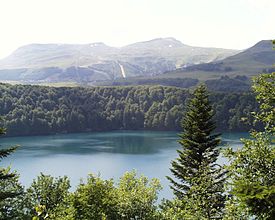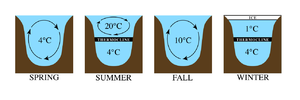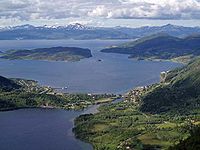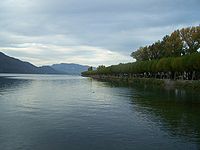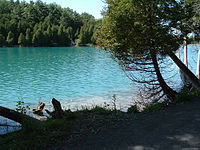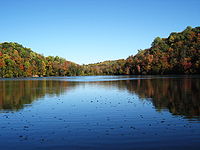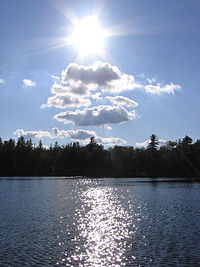- Meromictic lake
-
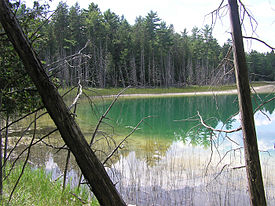 McGinnis Lake is a meromictic lake near Peterborough, Ontario.
McGinnis Lake is a meromictic lake near Peterborough, Ontario.
A meromictic lake has layers of water that do not intermix.[1] In ordinary, "holomictic" lakes, at least once each year there is a physical mixing of the surface and the deep waters.[2] This mixing can be driven by wind, which creates waves and turbulence at the lake's surface, but wind is only effective at times of the year when the lake's deep waters are not much colder or warmer than its surface waters.
The term "meromictic" was coined by the Austrian Ingo Findenegg in 1935, apparently based on the older word "holomictic". The concepts and terminology used in describing meromictic lakes were essentially complete following some additions by G. Evelyn Hutchinson in 1937.[3][4][5]
Contents
Characteristics
Lake zones Littoral zone Limnetic zone Profundal zone Benthic zone Lake stratification Epilimnion Metalimnion Hypolimnion Destratification Lake types Holomictic lake Monomictic lake Dimictic lake Polymictic lake Meromictic lake Amictic lake Aquatic ecosystems Wild fisheries Most lakes are holomictic; that is, at least once a year, physical mixing occurs between the surface and the deep waters. In monomictic lakes the mixing occurs once a year; in dimictic lakes the mixing occurs twice a year (typically spring and autumn), and in polymictic lakes the mixing occurs several times a year. In meromictic lakes, the layers of the lake water remain unmixed for years, decades, or centuries.
Among the consequences of this stable layering (or stratification) of lake waters is that the deeper layer (the "monimolimnion") receives little oxygen from the atmosphere. The monimolimnion becomes depleted of oxygen. While the surface layer (the "mixolimnion") may have 10 mg/l or more dissolved oxygen in summer, the monimolimnion in a meromictic lake has less than 1 mg/l.[6] Very few organisms can live in this oxygen-poor environment. One exception is purple sulfur bacteria. These bacteria, which are commonly found at the top of the monimolimnion in meromictic lakes, use sulfur compounds for photosynthesis; sulfur compounds are one of the products of sediment decomposition in "anoxic" (oxygen poor) environments.
This type of lake may form for a number of reasons:
- the basin is unusually deep and steep-sided compared to the lake's surface area
- the lower layer of the lake is highly saline and denser than the higher levels of water
The layers of sediment at the bottom of a meromictic lake remain relatively undisturbed because there is very little physical mixing and few living organisms to stir them up, and very little oxygen or chemical decomposition. For this reason corings of the sediment at the bottom of meromictic lakes are important research tools in tracing climate history at the lake.
When the layers do mix for whatever reason the consequences can be devastating for organisms that normally live in the mixolimnion. This layer is of a much smaller volume than the monimolimnion and therefore when they mix the oxygen concentration in mixolimnion will decrease dramatically. This may result in the death of many organisms such as fish that require oxygen.
Occasionally carbon dioxide (CO2) or other dissolved gases can build up relatively undisturbed in the lower layers of a meromictic lake. When the stratification is disturbed, as could happen due to an earthquake, a limnic eruption may result. In 1986, a notable event of this type took place at Lake Nyos in Cameroon, causing nearly 1,800 deaths.[7]
While it is mainly lakes that are meromictic, the world’s largest meromictic basin is the Black Sea. Here the deep waters below 50 metres (150 feet) do not mix with the upper layers that receive oxygen from the atmosphere. As a result, over 90% of the deeper Black Sea volume is anoxic water. The Caspian Sea is anoxic below 100 metres (300 feet). The Baltic Sea is persistently stratified with large hypoxic sediment areas below its halocline.
List of meromictic lakes
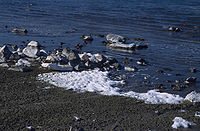 Soapy foam on the shore of Soap Lake
Soapy foam on the shore of Soap Lake
There are meromictic lakes all over the world. The distribution appears to be clustered, but this may be due to incomplete investigations. Depending on the exact definition of "meromictic", the ratio between meromictic and holomictic lakes are between 1:1000 and 1:3000.[8]
Africa
- Lake Nyos and Lake Monoun in Cameroon
- Lake Kivu in Rwanda
- Lake Tanganyika in Burundi, The DRC, Tanzania and Zambia
Antarctica
Asia
- Pantai Keracut (Keracut Beach) Lake, Penang National Park, northwest Penang island, Malaysia
- Jellyfish Lake (Ongeim'l Tketau), on Eil Malk in Palau
Australia
Europe
- Kärntner Seen (Alpine lakes in the Austrian province of Carinthia; studied by Ingo Findenegg in the 1930s).
- Lake Vähä-Pitkusta in Finland.
- Salsvatnet, Kilevann, Tronstadvatn, Birkelandsvatn, Rørholtfjorden, Botnvatn, Rørhopvatn and Strandvatn lakes in Norway.
- Lake Cadagno is a "crenogenic" meromictic lake in Switzerland, and the location of the Alpine Biology Center (Centro Biologia Alpina).
- Lac Pavin and Lac du Bourget[9] in France
- The Black Sea is also considered to be meromictic.
North America
- Ballston Lake, 30 km NNW of Albany, New York
- Crawford Lake near Milton, Ontario
- Fayetteville Green Lake and Round Lake, in Green Lakes State Park near Syracuse, New York
- Glacier Lake, in Clark Reservation State Park near Syracuse, New York
- Great Salt Lake near Salt Lake City, Utah
- Irondequoit Bay near Rochester, New York is also considered meromictic; use of road salt has been cited as the main reason for its change
- Lower Mystic Lake in Arlington and Medford, Massachusetts
- McGinnis Lake in Petroglyphs Provincial Park, Ontario
- Mahoney Lake in the Okanagan Valley, British Columbia
- Pink Lake in Gatineau Park, Quebec
- Redoubt Lake near Sitka, Alaska; one of North America's largest meromictic lakes.[10]
- Soap Lake in Washington
- Sunfish Lake near Waterloo, Ontario
- Devil's Bathtub near Rochester, New York in Mendon Ponds Park
- Blackcat Lake near Dorset, Ontario in Frost Centre
- Chapel Lake, in Pictured Rocks National Lakeshore, near Munising, Michigan [11]
References
Notes
- ^ Wetzel, Robert G. (2001). Limnology: Lake and River Ecosystems (Third Edition) (Academic Press, New York). ISBN 978-0127447605.
- ^ Lewis, William M., Jr. (1983). "A revised classification of lakes based on mixing". Canadian Journal of Fisheries and Aquatic Sciences 40 (10): 1779–1787. doi:10.1139/f83-207. http://cires.colorado.edu/limnology/pubs/pdfs/Pub058.pdf.
- ^ Hakala, Anu (2004). "Meromixis as a part of lake evolution - observations and a revised classification of true meromictic lakes in Finland," Boreal Environmental Research Vol. 9, pp. 37-53.
- ^ Findenegg, Ingo (1935). "Limnologische Untersuchungen im Kärntner Seengebiete. Ein Beitrag zur Kenntnis des Stoffhaushaltes in Alpenseen," Internationale Revue der Gesamte Hydrobiologie Vol. 32, pp. 369-423; as cited by Hakala (2004).
- ^ Hutchinson, G. Evelyn (1937). "A contribution to the limnology of arid regions," Transactions of the Connecticut Academy of Arts and Sciences Vol. 33, 47-132, as cited by Hakala (2004).
- ^ Lampert, Winfried and Sommer, Ulrich (1997). Limnoecology: The Ecology of Lakes and Streams (Oxford University Press, Oxford). Translation by James F. Haney. ISBN 978-0195095920.
- ^ Krajick, Kevin (2003). "Defusing Africa's Killer Lakes," Smithsonian Magazine, September 2003 issue.
- ^ Hakala (2005), page 20
- ^ Jacquet, Stéphan et al. (2003). "The proliferation of the toxic cyanobacterium Planktothrix rubescens following restoration of the largest natural French lake (Lac du Bourget)," Harmful Algae, 4:651-672.
- ^ Redoubt Lake Sockeye Salmon Enhancement and Monitoring, Tongass National Forest, US Forest Service
- ^ http://www.nps.gov/piro/naturescience/lakesandponds.htm
Bibliography
- Hutchinson, G. Evelyn (1957). A Treatise on Limnology. Volume I: Geography, Physics and Chemistry, (Wiley, New York). ISBN 978-0471425700.
- Hakala, Anu (2005). Paleoenvironmental and paleoclimatic studies on the sediments of Lake Vähä-Pitkusta and observations of meromixis, University of Helsinki doctoral dissertation.
External links
- "Density Stratification", part of an educational website Water on the Web operated by the University of Minnesota, Duluth. Retrieved 11-March-2007.
- Lake Fidler revived
- photo-outing.com review over Pantai Kerachut with Memomictic lake
Categories:- Lakes
- Meromictic lakes
Wikimedia Foundation. 2010.

